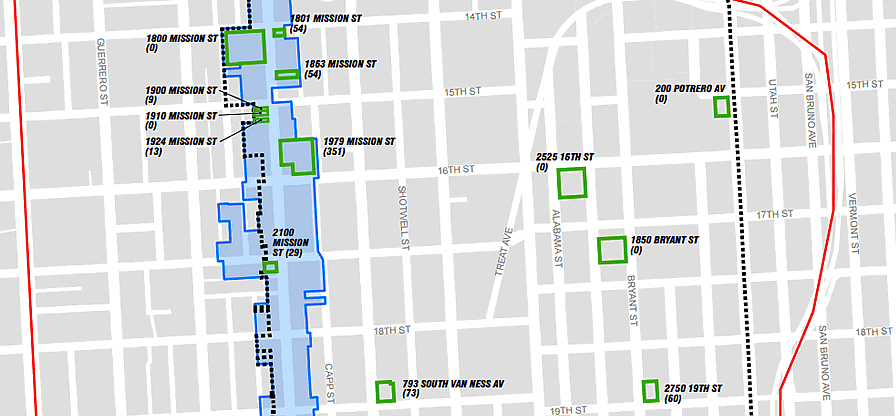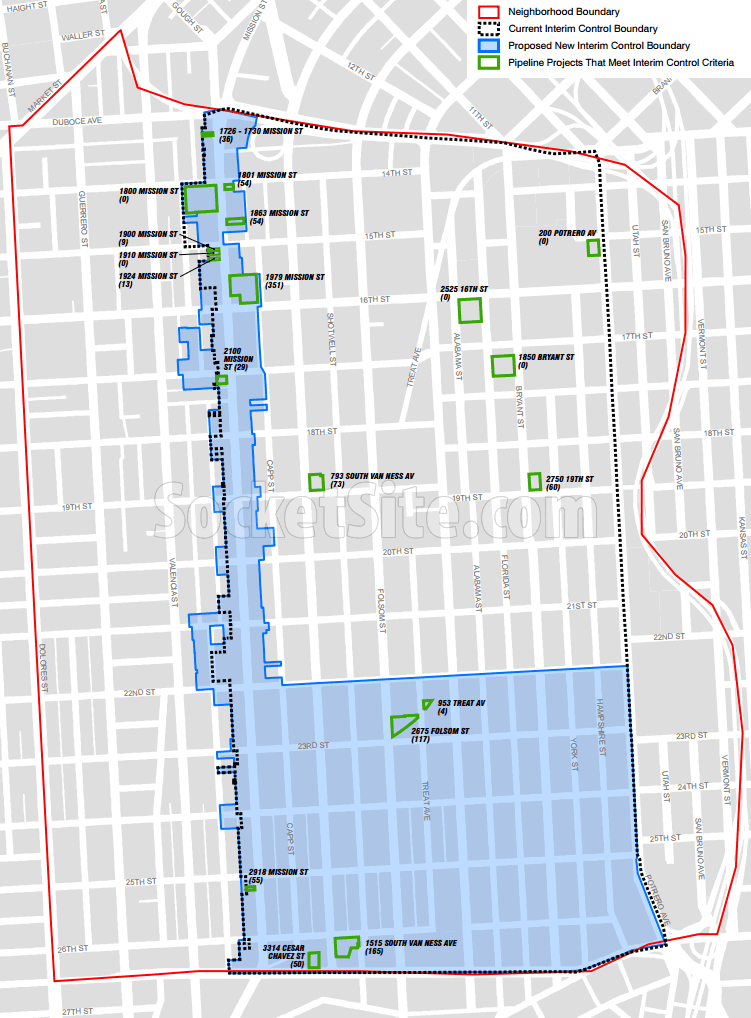The ‘Interim Controls’ to limit new market-rate housing, office and retail developments in the Mission District, which were adopted in January of last year and are scheduled to expire this April, are slated to be extended for another nine months, but with a few modifications.
Intended to provide time for the City to finalize “a cohesive strategy to provide more affordable housing and economic stability” and complete “an analysis of affordable housing needs, including potential sites for housing production in the Mission,” the controls require special Planning Commission authorization (either Conditional Use or Large Project) for developments that would result in the loss of one or more rent-controlled units or includes over 25 residential units or 25,000 square feet of non-residential space, along with a number of other nuances and requirements.
Residential projects that include at least 33 percent below market rate units and PDR developments are exempt from the controls, as are projects outside the current interim control boundaries as mapped above.
And with the proposed Mission Action Plan 2020 (MAP2020), which represents the City’s strategy for the neighborhood, slated to be endorsed by San Francisco’s Planning Commission this week, after which it will be up to San Francisco’s Board of Supervisors to adopt, the nine month extension of the interim controls is intended to bridge the gap until MAP2020 is in place.
That being said, the boundary of the area to which the interim controls would apply is to be reduced to the Calle 24 Special Use District and both sides of Mission Street from Duboce/13th to Cesar Chavez, within which there are at least 14 pipeline projects for which the controls would apply. And the pipeline projects at 793 South Van Ness Avenue and 2750 19th Street would no longer be within the boundaries of the controlled zone.


A textbook definition of Micromanagement
Let’s put in these stringent controls in one of the most transit-rich areas of the city, but developers can do whatever they want elsewhere in town. Yeah, makes a lot of sense. I think it goes beyond micromanagement.
So, being serious here.
How does a moratorium or development control improve the lives of those currently living in the Mission? Furthermore, how do the above make the FUTURE Mission a better place?
Nothing I’ve seen proposed or instituted will lower rents or slow the rise of rents, so what’s the point?
File this one under: signs that city planning is not being done by city planners:
Shoulda seen this one coming a mile away. The nutbar Mission activists freebasing on Mao’s Little Red Book have convinced themselves that anything other than 100% affordable causes “displacement”, even if built on a completely vacant lot. Local control over zoning decisions to the degree provided in California has completely eaten itself.
Time to start over. If local jurisdictions can’t accommodate growth, then its time for the state to step in and take over zoning, just like you would do for a failing school district.
Glad I don’t own in the Mission. Sure, I won’t have high property appreciation values or sky-high rental income but seriously this amount of city meddling is well beyond the scope of any reasonable real estate investment.
At this rate, I welcome federal rules over state development and zoning rules.
SF is not – and has not been for a while – a good place for the small to medium scale real estate investor. The appreciation is slowing significantly and being outpaced by places like Portland and Seattle. The sky-high rents – they don’t generally produce an ROI worth writing home about. JMO.
I do own my home in this district. Additionally, the Preservation Planners have declared my house to be a “historic resource,” without my knowledge. So my hands are further tied.
You can probably fight it. Depends on factors such as the age of the building, architecture, past residents, etc.
I prepared the report for the planning environmental review myself without any consultants and associated costs. Was quite interesting project actually finding out about the history of the house and who built and lived there.
unintended consquences… more gentrification. less housing equals higher prices, except for a lucky few lottery winners. this is just political grandstnding that helps no one, except those seeking votes.
Looks like my rental property just got swallowed up by these bureaucrats for better or worse. Given that they are against increasing building height limits and general development I feel this will probably increase its value.
Yes and no. No or limited growth areas are problematic. Look at North Beach and the Marina. One of my friends who is a much bigger landlord than me has eight new nicely renovated units in various buildings in the Marina (2 bd/1 bath for $3,600 per month,) all sitting vacant for several months in the current slow rental market. Good that his prior tenants who vacated were long-term tenants paying below market rents. Now it is a waiting game to get the units filled with market rate tenants.
I know rents in SF have come down, but I’m surprised that newly renovated 2 bedroom units in the Marina are having a hard time fetching 3600/month.
It is what it is. Maybe it is seasonal. Proof is in the spring/summer season.
Speaking of rents in San Francisco and moving any follow-up discussion that way: Cost of Renting a Room in SF Has Dropped 12 Percent from Peak.
except that their goal is also to keep mission full of junkies, homeless, with grafitti and trash.
They mean well – Mission Street will be paved with good intentions…
If I remember correctly, said road leads to prosperity for all.
So whats the plan here, are they just going to keep moving that boundary westwards.
Someone tell me Tommi Avioli-Mecca & Co will be re-locating to Venezuela soon.
The small minded no growth attitudes are mind boggling